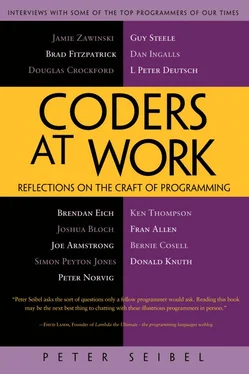Peter Seibel - Coders at Work - Reflections on the craft of programming
Здесь есть возможность читать онлайн «Peter Seibel - Coders at Work - Reflections on the craft of programming» весь текст электронной книги совершенно бесплатно (целиком полную версию без сокращений). В некоторых случаях можно слушать аудио, скачать через торрент в формате fb2 и присутствует краткое содержание. Жанр: Программирование, на английском языке. Описание произведения, (предисловие) а так же отзывы посетителей доступны на портале библиотеки ЛибКат.
- Название:Coders at Work: Reflections on the craft of programming
- Автор:
- Жанр:
- Год:неизвестен
- ISBN:нет данных
- Рейтинг книги:3 / 5. Голосов: 1
-
Избранное:Добавить в избранное
- Отзывы:
-
Ваша оценка:
- 60
- 1
- 2
- 3
- 4
- 5
Coders at Work: Reflections on the craft of programming: краткое содержание, описание и аннотация
Предлагаем к чтению аннотацию, описание, краткое содержание или предисловие (зависит от того, что написал сам автор книги «Coders at Work: Reflections on the craft of programming»). Если вы не нашли необходимую информацию о книге — напишите в комментариях, мы постараемся отыскать её.
Coders at Work
Founders at Work
Coders at Work: Reflections on the craft of programming — читать онлайн бесплатно полную книгу (весь текст) целиком
Ниже представлен текст книги, разбитый по страницам. Система сохранения места последней прочитанной страницы, позволяет с удобством читать онлайн бесплатно книгу «Coders at Work: Reflections on the craft of programming», без необходимости каждый раз заново искать на чём Вы остановились. Поставьте закладку, и сможете в любой момент перейти на страницу, на которой закончили чтение.
Интервал:
Закладка:
Seibel:On a completely different topic, what’s the worst bug you ever had to track down?
Eich:Oh, man. The worst bugs are the multithreaded ones. The work I did at Silicon Graphics involved the Unix kernel. The kernel originally started out, like all Unix kernels of the day, as a monolithic monitor that ran to completion once you entered the kernel through a system call. Except for interrupts, you could be sure you could run to completion, so no locks for your own data structure. That was cool. Pretty straightforward.
But at SGI the bright young things from HP came in. They sold symmetric multiprocessing to SGI. And they really rocked the old kernel group. They came in with some of their new guys and they did it. They stepped right up and they kept swinging until they knocked the ball pretty far out of the field. But they didn’t do it with anything better than C and semaphores and spin locks and maybe monitors, condition variables. All hand-coded. So there were tons of bugs. It was a real nightmare.
I got a free trip to Australia and New Zealand that I blogged about. We actually fixed the bug in the field but it was hellish to find and fix because it was one of these bugs where we’d taken some single-threaded kernel code and put it in this symmetric multiprocessing multithreaded kernel and we hadn’t worried about a particular race condition. So first of all we had to produce a test case to find it, and that was hard enough. Then under time pressure, because the customer wanted the fix while we were in the field, we had to actually come up with a fix.
Diagnosing it was hard because it was timing-sensitive. It had to do with these machines being abused by terminal concentrators. People were hooking up a bunch of PTYs to real terminals. Students in a lab or a bunch of people in a mining software company in Brisbane, Australia in this sort of ’70s sea of cubes with a glass wall at the end, behind which was a bunch of machines including the SGI two-processor machine. That was hard and I’m glad we found it.
These bugs generally don’t linger for years but they are really hard to find. And you have to sort of suspend your life and think about them all the time and dream about them and so on. You end up doing very basic stuff, though. It’s like a lot of other bugs. You end up bisecting—you know “wolf fence.” You try to figure out by monitoring execution and the state of memory and try to bound the extent of the bug and control flow and data that can be addressed. If it’s a wild pointer store then you’re kinda screwed and you have to really start looking at harder-to-use tools, which have only come to the fore recently, thanks to those gigahertz processors, like Valgrind and Purify.
Instrumenting and having a checked model of the entire memory hierarchy is big. Robert O’Callahan, our big brain in New Zealand, did his own debugger based on the Valgrind framework, which efficiently logs every instruction so he can re-create the entire program state at any point. It’s not just a time-traveling debugger. It’s a full database so you see a data structure and there’s a field with a scrogged value and you can say, “Who wrote to that last?” and you get the full stack. You can reason from effects back to causes. Which is the whole game in debugging. So it’s very slow. It’s like a hundred times slower than real time, but there’s hope.
Or you can use one of these faster recording VMs—they checkpoint only at system call and I/O boundaries. They can re-create corrupt program states at any boundary but to go in between those is harder. But if you use that you can probably close in quickly at near real time and then once you get to that stage you can transfer it into Rob’s Chronomancer and run it much slower and get all the program states and find the bug.
Debugging technology has been sadly underresearched. That’s another example where there’s a big gulf between industry and academia: the academics are doing proofs, sometimes by hand, more and more mechanized thanks to the POPLmark challenge and things like that. But in the real world we’re all in debuggers and they’re pieces of shit from the ’70s like GDB.
Seibel:In the real world one big split is between people who use symbolic debuggers and people who use print statements.
Eich:Yeah. So I use GDB, and I’m glad GDB, at least on the Mac, has a watch-point facility that mostly works. So I can watch an address and I can catch it changing from good bits to bad bits. That’s pretty helpful. Otherwise I’m using printfs to bisect. Once I get close enough usually I can just try things inside GDB or use some amount of command scripting. But it’s incredibly weak. The scripting language itself is weak. I think Van Jacobson added loops and I don’t even know if those made it into the real GDB, past the FSF hall monitors.
But there’s so much more debugging can do for you and these attempts, like Chronomancer and Replay, are good. They certainly changed the game for me recently. But I don’t know about multithreading. There’s Helgrind and there are other sort of dynamic race detectors that we’re using. Those are producing some false positives we have to weed through, trying to train the tools or to fix our code not to trigger them. The jury is still out on those.
The multithreaded stuff, frankly, scares me because before I was married and had kids it took a lot of my life. And not everybody was ready to think about concurrency and all the possible combinations of orders that are out there for even small scenarios. Once you combine code with other people’s code it just gets out of control. You can’t possibly model the state space in your head. Most people aren’t up to it. I could be like one of these chestthumpers on Slashdot—when I blogged about “Threads suck” someone was saying, “Oh he doesn’t know anything. He’s not a real man.” Come on, you idiot. I got a trip to New Zealand and Australia. I got some perks. But it was definitely painful and it takes too long. As Oscar Wilde said of socialism, “It takes too many evenings.”
Seibel:How do you design code?
Eich:A lot of prototyping. I used to do sort of high-level pseudocode, and then I’d start filling in bottom up. I do less of the high-level pseudocode because I can usually hold it in my head and just do bottom-up until it joins. Often I’m working with existing pieces of code adding some new subsystem or something on the side and I can almost do it bottom-up. When I get in trouble in the middle I do still write pseudo-code and just start working bottom up until I can complete it. I try not to let that take too long because you’ve got to be able to test it; you’ve got to be able to see it run and step through it and make sure it’s doing what it’s supposed to be doing.
Before that level of design, there may be some entity relationships or gross modularization. There’s probably an algorithm or three that we’re thinking of where you’re reasoning about the complexity of it—is it linear? Is it constant? Every time I’ve written some kind of linear search that’s going to compound quadratically, and unleashed it on the Web, web developers have found that to be a problem. They’ve written enough stuff it stresses it. So we tend to do a lot of data structures that are constant time. And even then, constant can be not one—it can be big enough that you care.
So we do lots of prototyping, we do lots of bottom-up and top-down and they meet in the middle. And I think actually we, at Mozilla, don’t do enough rewriting. We’re very conservative. We are open source, so we have community we try to build and bring new people into. We certainly have value that users benefit from, and we don’t want to take a three-year break rewriting, which is what would happen if we tried too much.
Читать дальшеИнтервал:
Закладка:
Похожие книги на «Coders at Work: Reflections on the craft of programming»
Представляем Вашему вниманию похожие книги на «Coders at Work: Reflections on the craft of programming» списком для выбора. Мы отобрали схожую по названию и смыслу литературу в надежде предоставить читателям больше вариантов отыскать новые, интересные, ещё непрочитанные произведения.
Обсуждение, отзывы о книге «Coders at Work: Reflections on the craft of programming» и просто собственные мнения читателей. Оставьте ваши комментарии, напишите, что Вы думаете о произведении, его смысле или главных героях. Укажите что конкретно понравилось, а что нет, и почему Вы так считаете.












